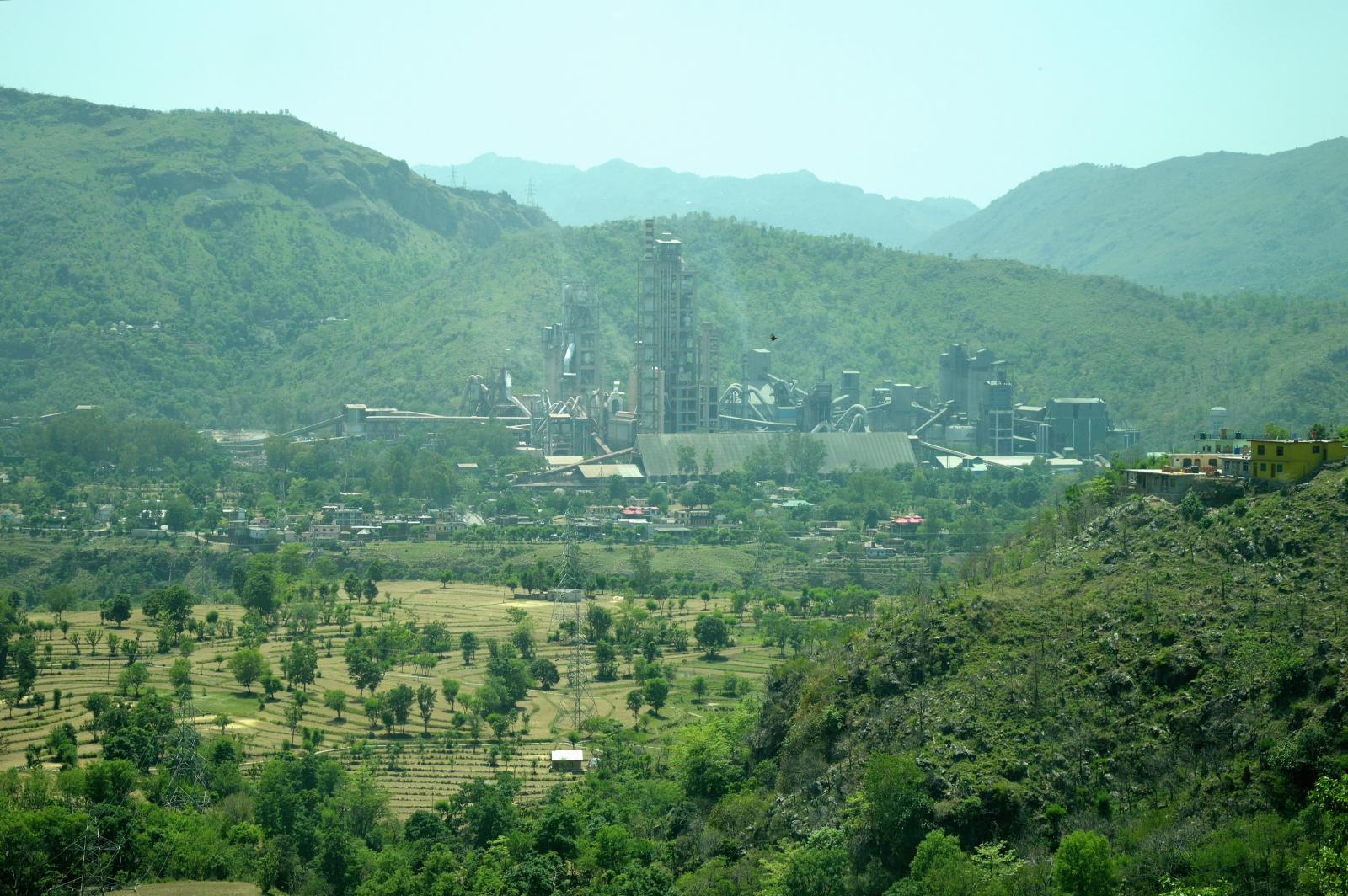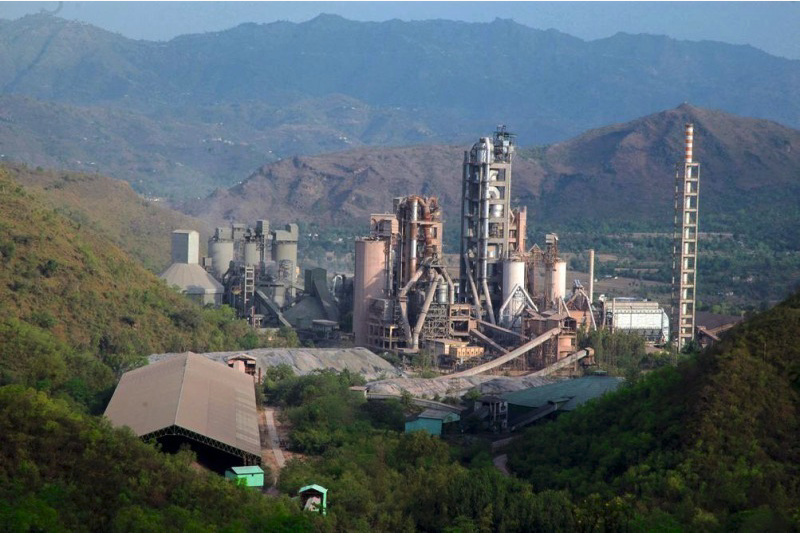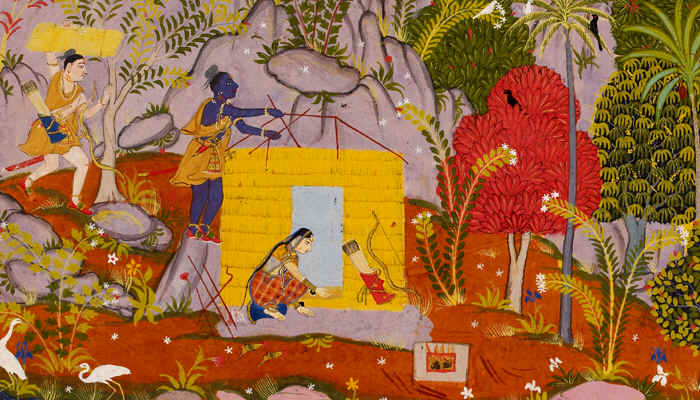The Ramayana was written between the 7th and 4th century BCE, and its composition is traditionally ascribed to Valmiki. However, as shown in the previous essay, the Indian epic tradition has remained perennially contemporary ever since it first emerged. For instance, over the course of past several centuries, the Ramayana has been reinvented and repurposed in a range of different language and literary cultures across vast swathes of South and Southeast Asia. Even though Valmiki’s composition is the oldest known composition, it is not an ur-text by any means. Instead, as A.K. Ramanujan felicitously averred, there is no Ramayana as such, only its different “tellings.” There are anywhere between three hundred and three thousand Ramayanas, likely even more, and Valmiki’s telling is only one of them. Moreover, these tellings are not always “textual,” and likewise the devotees’ relationship to them is not always hermeneutic or exegetical. Instead, per Paula Richman, it would be more appropriate to think of these tellings as “living texts,” whose performative dimensions emphatically confound and subvert the rather impoverished binary of “literacy/orality.”
Who gets to tell the Ramayana? What forms of tellings are “permitted”? What happens when certain religious communities begin to consecrate the Ramayana as an immutable sacred text? These questions are not always easy to settle. Often, the Ramayana tellings become subjects of intense sociopolitical and religious conflicts. But what is important to note is that these tellings do not just passively express the terms and forms of these conflicts. Rather, they also sometimes actively intervene in them, and under certain conditions, they can even inflect the larger structural movements of history. As I suggested in the previous essay, this was specifically the case with the TV Ramayana, a particular telling of the literary epic that was broadcast on national television, and that promptly served to catalyze the emergence of the Hindu rightwing on the eve of the largest political-economic crisis in postcolonial India. This, however, is not to suggest that the TV Ramayana caused Hindu fascism (as if!), but simply that it singularly shaped the form of its incipient emergence. Moreover, given how the BJP-led rightwing recently decided to consummate its latest cycle of fascist violence in India by re-broadcasting this TV adaptation, there should be little doubt concerning the centrality of the epic for understanding the twinned trajectories of the Hindu rightwing and the economic liberalization in India.

Let me, then, begin by setting the stage for exploring this political centrality of the epic. Only, as it turns out, it is literally a stage, an actual raised platform situated in the foothills of the Himalayas, where, every year, the Hindu factory workers—mostly the upper castes— performed Ramlila, a dramatic folk enactment of the life of Rama, during the holy festival of Navaratri. The workers played out their telling of the Ramayana in a rather unique social setting— amidst a cluster of remote villages in the north Indian state of Himachal Pradesh, where, unexpectedly enough, a Fordist-styled cement factory had materialized practically overnight. In addition to staging the Ramlila, the workers also sang parts of Ramcharitmanas, an epic telling of Ramayana composed by Tulsidas in the Avadhi vernacular during the late 16th century, every week at the local temple. Centered around the sacred figure of Rama, this religious milieu formed a prominent part of the workers’ collective social life, which had been utterly riven, firstly, by the factory’s capitalist imperatives of commodity production, and secondly, by its economic and ecological incursions into the surrounding villages, organized by the Brahmanical strictures of the caste system. And as it turned out, it was precisely these political entanglements between class and caste that provided the profane setting to the sacred drama of Rama’s life, extensively consecrated and staged by the workers on a regular basis.
The construction of Gagal Cement Works, as the factory eventually came to be known, started in 1979, when A.C.C., then the largest cement company in India, discovered limestone in the surrounding foothills. The stage, along with the large rectangular ground it was situated in, was constructed much later, sometime during the early-1990s. The sheer flatness of this ground stood out, not least because it was one of the few spaces in the colony that was completely flat. The rest of the colony had been mostly laid out on the hilly valley as it was. The colony was designed in a way that the natural incline of the valley’s ascent served to index the political-economic gradient of the workers’ class positions. A significant section of the workers lived at the bottom, closer to the factory and the relentless traffic of cement trucks moving about on the national highway. They lived in small tenement buildings facing a handful of retail shops. Meanwhile, the meandering ascent of the hill, dotted with differently designed tenements, indexed a corresponding rise in the residents’ class positions. But since the colony had been built in stages, there were also some exceptions to this rule, as the hilly ascent often split off into several jagged uplands and plateaus. Still, the bottom and the top of the ascent formed uncanny inversions of each other. At the top, senior managers lived in big bungalows, set amidst verdant gardens and nurseries of flowers and fruits, looking onto undulating vistas of distant hills and the flowing Sutlej, far from the smoke and clangor of what Marx aptly described as “the hidden abode of production,” hidden because here lay “the secret of profitmaking,” namely, the ruthless exploitation of the working class. Meanwhile, in this horticultural Eden, the factory almost did not exist.
In this cement factory, a worker typically started out as a temporary employee. After a year or two, he earned his “promotion,” and joined the “Wage Board.” In addition to becoming a member of the workers’ union, he now received a yearly bonus in addition to a monthly salary with “added benefits.” The Wage Board was composed of seven different grades, which served to structure the entire labor force spread out across different departments, ranging from the mines to the HR, and the kiln to the packing house. Any worker who managed to receive seven promotions transitioned into the “Company Grade.” He now lost his membership of the workers’ union and no longer received a yearly bonus. But this loss of the yearly bonus was more than made up for by a significantly enhanced monthly salary. And as for the union membership, the worker no longer needed it. For he had already crossed over into the sphere of the union’s class antagonists, even though it would be a while before he could properly become one of them. Like the Wage Board, the Company Grade was also composed of several different rungs—the Officer; the Assistant Manager; the Deputy Manager; the Manager; the Chief manager 1; the Chief Manager 2; the Assistant General Manager; the General Manager; Senior General Manager; Plant Director. In his lifetime, a “good worker” was able to just about reach the lower echelons of the Company Grade, but the rest was almost always beyond his reach.
This, then, was the typical bildungsroman of a factory worker: a telos of promotions, punctuating distinct stages and intensities of exploitation, bearing him towards the promise of “the great transition,” where the worker, hitherto exploited for several decades, would be reborn as the enforcer of exploitation. But this temporal movement was accompanied by shifts in space, too. With every promotion, the worker trudged along the uneven folds of the hilly valley, moving through a range of different housing arrangements in different tenement buildings. A single room with no kitchen and common bathrooms, split between three workers. A two-room set with kitchen and bathroom, split between two families. A two-room set for one family. A two-room set with a balcony. A three-room set without a balcony. A two-room set with a kitchen garden. A three-room set facing the sewage plant. And then, there were standalone houses—some smaller, some bigger—for the workers who had tipped over into the Company Grade. These were built farther away from the factory, with more rooms and a small garden, but were still dwarfed by the bigger bungalows on the top of the hill. In 1980, when these Himalayan foothills were still in wilderness, my father arrived as a migrant from the neighboring Punjab. He was promptly hired as a temporary worker in the account’s office. Like other temporary workers, his contract included minimal wages and no benefits, except the permission to spend the night sleeping on an office desk. Like other temporary workers and migrants, my father was also regularly deployed by the company to break the picket lines erected by the still emerging workers’ union, composed primarily of local villagers. My father started at the bottom of the hill, and nearly forty years later, he ended up somewhere in between, on a plateau, closer to the top than to the bottom. An assistant manager in a standalone house facing the sewage plant.

But it was not capitalism alone that determined the workers’ social life both in the factory and the colony. Just like the Hindu society at large, here too, the structural violence of caste was at work. Drawing a distinction between the two, B.R. Ambedkar famously asserted that “caste was a division of laborers and not just of labor.” That is, where labor hierarchies in the factory divided, say, a welder from a foreman, the caste system operated dividing a welder from another welder. In contrast to the capitalist hierarchies of skilled and unskilled labor, which are ultimately subjected only to the “law of value,” the caste system has, as Ambedkar succinctly put it, “a divine basis.” Its regime of “graded inequalities” between “self-enclosed classes” is sanctioned by Brahmanical scriptures, and it has traditionally served to structure the entire lifeworld of Hindu society, from the political-economic relations of land and labor to the molecular realities of everyday religious and cultural milieus. For instance, in the villages surrounding the cement factory, the caste system did not only mandate the unequal distribution of land and labor, whereby the Dalits and the Bahujans were economically dispossessed, and forced to engage in ritually impure occupations; but rather, the caste-based conflicts and Brahmanical stigmas also suffused the seemingly apolitical facets of everyday culture, facets as innocuous as the formation of volleyball teams in a local sports tournament. The history of the caste system in South Asia is long and complex, and it has undergone multiple historical transformations during the pre-colonial, colonial, and postcolonial periods. In the coming months, I will continue to puzzle over both this immense history of Brahmanical domination and the intense political debates that have long riddled the distinction between caste and class. Presently, however, I will limit myself to illustrating how, inside this cement factory, the workings of the caste system were deeply entangled with the capitalist workings of class.
Just like Ambedkar asserted, the caste system, indeed, divided the factory workers. But as it turned out, this caste-based division of workers was itself divided, not least because the factory’s workforce comprised of both migrants and local villagers. Many of the upper-caste villagers, who worked in the factory, were either landowning farmers or landlords. In fact, many of them had once owned the very lands on which the factory and the colony now exists. They formed part of the factory’s workforce alright, but they were also landed and rich, and had become richer still, after selling large swathes of their lands to the A.C.C. Their land entitlements were directly legitimized by the caste system, and upon entering the factory, they concertedly strove to both assert and secure their caste hegemony. For one, they dominated the factory’s union, even spearheading, in the early days, a forceful campaign against incoming migrant workers, by demanding increased “local representation” in the factory’s workforce. However, what these upper-caste villagers were actually demanding was a representation of caste in the composition of the factory’s workforce, so that they could extend their hegemony from the villages to the factory, thereby warding off the “threat” posed by incoming migrants, many of whom were upper-castes too, but who threatened to upset the local caste dynamics because they made for a far more pliant and cheaper workers. Similarly, the upper-caste villagers also dominated the truckers’ union, responsible for regulating the transportation of cement to the markets. However, the union was largely comprised of the truck owners, none of whom actually drove the trucks, but instead hired them out on formal and informal contracts to local and migrant drivers.
Traditional Marxists have long agonized over how the capitalist political economy ultimately determines the workings of the caste-system. But even this tendentious snippet should suffice to clarify that it is not simply a question of whether capitalism determines the workings of the caste-system, or not. The politics of class and caste are coterminous, each dialectically entangled with the workings of the other. For instance, inside the factory, class was crosshatched by caste, and vice-versa. There were times when these two structures of “division” unpredictably antagonized each other, but mostly each served to reproduce the violent workings of the other. It benefitted the factory management to have a workforce riven by the caste system, not only because it made for an especially vitiated workers’ union, but also because it gave the local elites a semblance of continuity between the social relations in the village and in the factory. But even as the factory management allowed the caste hierarchies to subsist, it also subtly subordinated them to the capitalist imperatives of profit-making, ensuring that they did not get in their way. Similarly, far from concertedly challenging the exploitation of workers within the factory, the upper-caste villagers, and later the upper-caste migrants, were largely concerned with translating their own caste hierarchies into class mobility. A fuller outline of these fraught relationships between class and caste-based solidarities and antagonisms, and a specifically gendered division of labor, will have to wait for another essay. What concerns me, here, is how these class and caste-based solidarities and antagonisms were borne out in the religious milieu of upper-caste Hindus, both local villagers and migrants, and more importantly, how I experienced these religious mediations during my childhood.
For nearly a decade and a half, my brother and I regularly participated in the weekly ritual singing of the Ramcharitmanas and performed different roles in the annual Ramlila. During these years, the ongoing political transformations in the rest of the country slowly but surely transformed the workers’ religious practices. Now, another decade and a half later, I return to this upper-caste Hindu religious milieu, driven both by personal and political exigencies. This upper-caste milieu, centered around the sacred figure of Rama, formed the inaugural scene of instruction in my life, and in the wake of the unprecedented political victories of the Hindu rightwing, I have found myself driven to exploring what it means to historically grapple with the religious aspirations and attachments of a people whose political convictions I have now come to detest. But apart from being a personal liability, as it were, this religious milieu also, historically speaking, makes for a useful political lesson. As I intend to show in the coming months, the sacred churning of this religious milieu—its subjects and scenes, signs and sensations—clarifies the secular impasses of not just the working-class politics at this one cement factory, but also that of the Hindu working class in general. And in doing so, it also inadvertently rehearses the political challenge that Ambedkar had first posed to Marxism many decades ago, and that Marxists in India have often failed to take on. I return to these scenes of instruction from my childhood, but only in order to rewrite them as scenes of instruction for myself and my contemporaries, who have long been struggling to overcome the clarion limits of left-liberal secularism and Brahmanical Marxism alike.
Over the course of the coming months, I will unravel the grinding asynchronicity between the personal and the political one episode at a time. But I must emphasize that this unravelling will be partial, owing both to the form and the purpose of this blog. These episodes intend to conceptualize the movements of recent postcolonial history, more specifically, the relationship between rise of the Hindu rightwing and the crisis-ridden trajectory of postcolonial capitalism. But instead of taking the form of citation-larded essays, these conceptualizations will be speculative in nature. The Epic Present aspires to a writerly practice that can capture not only the swarming bustle of world-historical events but also those roundabout vagaries that have been waylaid by these events, and which now appear to be entirely inconsequential to the movements of history. Say, then, not only the heroic legacies of anti-capitalist and anti-caste struggles in the Indian subcontinent, but also the personal memories of a devout young boy playing Ganesha, the elephant god, at a local Ramlila, who, after repeatedly ramming into the microphones placed on the stage, eventually realized that instead of conferring upon him the divine blessings of Ganesha, the defective elephant mask had actually rendered him blind. Instead of worrying too much about seeing, or rather representing, the long and complex totality of South Asian history, the forthcoming episodes will take their inspiration from Brecht’s sly love for plumpes denken (“crude thinking”). They will stick to the “minor form” of the blog, and improvise a precipitous montage of stories and anecdotes, fake news and footnotes, prose poems and parables, in order to bricolate the microscopic contingencies of an individual’s religious lifeworld with the structural entanglements of class and caste, while tracing how this religious lifeworld constituted a specific stance—mostly of complicity and collusion, but also sometimes of critique and resistance—towards them.
